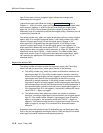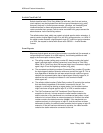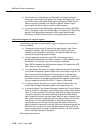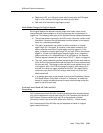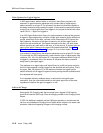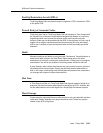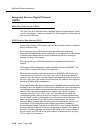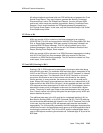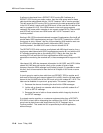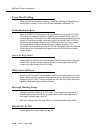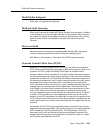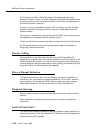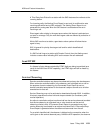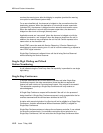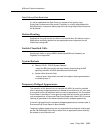
ASAI and Feature Interactions
12-46 Issue 7 May 1998
If calls are to be placed from a DEFINITY ECS running R6.3 software to a
DEFINITY ECS running an earlier version, then the trunk group used for these
calls should be administered with the ”UUI IE Treatment” set to “service-provider”.
This will cause the ECS running R6.3 to include only the data produced by ASAI
in the UUI IE which it sends over the ISDN trunk. In this case the LAI data will be
sent in a codeset 6 LAI IE, if the ISDN network in the trunk group supports
codeset 6 IEs (some public networks do not support codeset 6 IEs). Data for BSR
and UCID will not be sent over ISDN trunks with “UUI IE Treatment” set to
“service-provider”.
Starting in R6.3 PRI trunks administered to support Supplementary Service B will
provide basic QSIG supplementary services. If the UUI IE Treatment for a QSIG
trunk group is set to “shared”, then the UUI provided by ASAI would be sent over
the ISDN trunk in Manufacturer Specific Information (MSI). If set to
“service-provider”, the ASAI UUI is sent in the non-shared UUI IE.
The DEFINITY ECS which receives a call placed with MSI should receive it on a
trunk group administered with QSIG (supplementary service B), and with the UUI
IE Treatment matching that on the sending ECS. If that is the case, then the
receiving ECS will send the UUI that originated from ASAI to any ASAI
associations monitoring the received call, in those messages which support a UUI
IE.
Like shared UUI, MSI also transports information for LAI, BSR, and UCID. Unlike
shared UUI, MSI does not impose a limit on the number of bytes of data.
However, the entire ISDN message is still limited in length. It is possible to reach
this limit, but it is less restrictive than the limit of 32 bytes of UUI found on some
networks.
If a trunk group is used to place calls from one DEFINITY ECS to another and if
both ends of the trunk group support shared UUI (or MSI), then the LAI data would
be sent in the UUI (MSI) sent on the PRI trunk, and in the codeset 6/7 LAI IE. The
latter can be disabled on a per-trunk -group basis. This serves 3 purposes:
1. Decrease the chance of reaching the size limit for ISDN messages.
2. Let the call go through on networks which block a call with codeset 6 or 7
IEs in its SETUP message.
3. Decrease the cost of calls on those networks which charge by the size of
the SETUP message.
If a network service provider, or a customer equipment other than a DEFINITY
ECS (R6.3 or later) will be interpreting the contents of the UUI IE, then the trunk
group used to place those calls should have its UUI IE Treatment set to
“service-provider”. This sends the UUI as specified by the ASAI application,
without change.



